将养殖场磷平衡作为实现河流和湖泊水质目标的一项措施。
IF 8
2区 环境科学与生态学
Q1 ENVIRONMENTAL SCIENCES
引用次数: 0
摘要
这篇短文提出了一种利用农业耕作磷平衡 (FPB) 实现河流和湖泊水质磷 (P) 目标的途径。背景是北爱尔兰(NI)具有国际重要性的尼格湖和一般河流网络。一项荟萃分析表明,在 18 年内,FPB 与 93 个河流站点的可溶性活性磷 (SRP) 平均浓度之间存在直接且紧密的线性关系(R2 = 0.73,p -1 yr-1),100% 的河流 SRP 平均年浓度将至少改善至 SRP 状态的中/良好边界目标,25% 的河流 SRP 平均年浓度将改善至良好/高状态。在尼格湖,中度/良好边界目标是 0.044 毫克/升的湖内年均总磷 (TP) 浓度。在尼格湖的八条主要河流中,要达到这一目标,按流量加权平均浓度 (FWMC) 归一化的年总磷负荷为 0.109 mg L-1。与 FPB 相比,将 TP FWMC 数据应用五年时滞也表明,5.5 kg ha-1 yr-1 是达到这一湖内目标的方法(R2 = 0.72,p.本文章由计算机程序翻译,如有差异,请以英文原文为准。
The farmgate phosphorus balance as a measure to achieve river and lake water quality targets
This short communication proposes a pathway for achieving river and lake water quality phosphorus (P) targets using the agricultural farmgate P balance (FPB). The context is the internationally important Lough Neagh and general river network in Northern Ireland (NI). A meta-analysis shows a direct and strong linear relationship between the FPB and, with a one-year lag, the mean soluble reactive phosphorus (SRP) concentration for ninety-three river sites over eighteen years (R2 = 0.73, p < 0.01) during quiescent conditions. The model suggests that a reduction of the national FPB to 5.5 kg ha−1 yr−1 will improve up to 100% of river SRP mean annual concentrations to at least the moderate/good boundary target for SRP status, and 25% to the good/high status. In Lough Neagh, the moderate/good boundary is an in-lake mean annual total P (TP) concentration target of 0.044 mg L−1. The annual TP load normalised to a flow weighted mean concentration (FWMC) required to achieve this target in the eight major Lough Neagh rivers is 0.109 mg L−1. Applying a five-year time lag to the TP FWMC data when compared to the FPB also indicates 5.5 kg ha−1 yr−1 as a way to reach this in-lake target (R2 = 0.72, p < 0.01). Allowing for non-FPB sources being part of P mitigation strategies would either speed up the process of P reductions in rivers and to lakes, or relieve the burden to the agricultural sector if a FPB was increased proportionally to an optimum target.
求助全文
通过发布文献求助,成功后即可免费获取论文全文。
去求助
来源期刊

Journal of Environmental Management
环境科学-环境科学
CiteScore
13.70
自引率
5.70%
发文量
2477
审稿时长
84 days
期刊介绍:
The Journal of Environmental Management is a journal for the publication of peer reviewed, original research for all aspects of management and the managed use of the environment, both natural and man-made.Critical review articles are also welcome; submission of these is strongly encouraged.
 求助内容:
求助内容: 应助结果提醒方式:
应助结果提醒方式:


